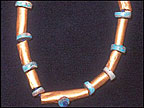
New evidence reported in the journal Science indicates
that humans populated North America at least 14,300 years ago, 1,200 years prior
to previous evidence on human habitation on the continent. The new information
is based on the oldest human DNA found in fossilized human feces, called
coprolites, in caves near Eugene, Oregon.
This new information calls into question the migration routes via Siberia they
might have used based on the ice bridge and glaciation in the Bering Sea area at
the time. It is now thought that they came by way of a coastal route rather than
an inland route, if indeed this is how they came to be on the continent.
The remnants of the oldest ceremonial plaza in the Americas dating back 5,500
years was recently discovered north of Lima in Peru. Built on the site of even
older complexes, these archaeological digs give us an appreciation of the rich
indigenous civilizations in the western hemisphere older than the pyramids of
Egypt. Another discovery of note this year was a 4,000 year old gold necklace,
also in Peru, the oldest gold artifact found the Americas, 600 older than the
previous record holder.
In future some of our current theories and beliefs may be upended by discoveries
of even earlier civilizations and new understandings of how these peoples came
to be and how they lived. It is often wise, therefore, to regard scientific
“beliefs”, whether in medicine, pharmacy, economics, archaeology, etc. with
discernment rather than submit to immediate conversion. Test with wisdom,
experience, intuition.
This new information reveals the existence of civilizations thousands of years
before the Europeans “discovered” the new land and conquered their descendants.
They had built cities, pyramids, calendars, systems of surveying and governance
and even complex systems of arithmetic, often reflecting their oneness with the
cosmos. Far from being “primitive” as we may have learned in our early
schooling, the evidence to date is amazing and humbling. Stay tuned – there's
surely more to come.